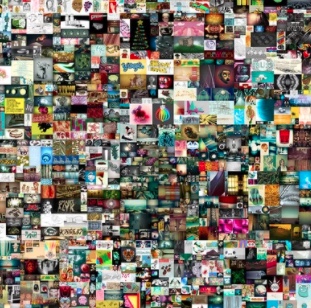 This week the art auction house Christie’s sold a work of art for $69M. What is noteworthy here is that the artist Mike Winkelmann had until last fall never sold any of his works for more than $100. Entitled Everydays: The first 5000 days, (a portion of it shown here) the artwork was entirely a digital work. The buyer got a digital record of the work, but not the graphics file itself. What was interesting about the sale was the bidding process, typical of a valuable eBay collectible: the auction had to be extended several minutes as dozens of hopeful buyers bid the price up in the last moments. You would think they were bidding on a “analog” DaVinci or a Degas. The piece, as you can see, is a digital file composed of a mosaic of other digital files. How meta!
This week the art auction house Christie’s sold a work of art for $69M. What is noteworthy here is that the artist Mike Winkelmann had until last fall never sold any of his works for more than $100. Entitled Everydays: The first 5000 days, (a portion of it shown here) the artwork was entirely a digital work. The buyer got a digital record of the work, but not the graphics file itself. What was interesting about the sale was the bidding process, typical of a valuable eBay collectible: the auction had to be extended several minutes as dozens of hopeful buyers bid the price up in the last moments. You would think they were bidding on a “analog” DaVinci or a Degas. The piece, as you can see, is a digital file composed of a mosaic of other digital files. How meta!
This is the brave new world of what is being called non-fungible tokens (NFTs) or crypto art. This world is heavily into cryptocurrencies, blockchains, smart digital contracts and other totems of tech. Even if you think you understand what each of these things means in isolation, you might not be able to wrap your brain around this concept entirely. So you should start with this post on GitHub, which explains some of the movers and shakers, links to where you can purchase other crypto art works, how the various tech pieces fit together, and other components of this ecosystem. The NY Times documents some of the other crypto works that have recently sold for multiple millions of dollar-equivalents (the actual transactions typically happen via Ethereum), such as a digital copy of Jack Dorsey’s first Tweet. One analog art collector commented about the Christie’s sale that “Art is no longer about a relationship with an object. It’s about making money,” he said. “I feel bad for art.” As someone who has purchased a few analog pieces myself (more on that in a moment), I would tend to agree.
The site CryptoSlam keeps track of recent transactions and should convince you that this is now A Thing. Tim Schneider writes this excellent piece about the crypto art evolution and mentions four important and unresolved issues:
- Who really owns what? As I mentioned, these works are really selling digital licenses and descriptions but not he bits of the digital art itself. The art is hosted elsewhere – what happens if the hosting provider disappears? Or if your digital wallet is compromised?
- Will gatekeepers be the same old rich white boys club or have a chance to decentralize and diversify? Or put another way, is there an opportunity for grassroots and sustainable tech platforms to take hold that will encourage a more pluralist art world?
- Will collectors be the same old RWBC, or worse –the rich tech bros from Silicon Valley? How the gatekeepers and collectors interact will be critical for the future success of the crypto art world.
- The old system benefitted the collector on resale of the art. Can crypto-based systems benefit the artist since they can track ownership forever? But while using existing ETH-based smart contracts is a step in the right direction, it is just a small step. Most of these contracts don’t contain any resale/redistributions provisions. The Mint fund is trying to solve this in a different way by giving grants and getting new artists started and trying to diversify the creators beyond the US/EU RWBC axis.
This last point deserves further discussion. One crypto artist is Sara Ludy. She wrote smart contracts that lays out the revenue share arrangement, now and forever, for her works. She keeps half of any sale for herself, 15% goes to the crypto marketplace/platform she chooses to sell with, and then the remaining 35% to her gallery, where it is divided among the staff in equal portions. That means as the price of the art work escalates, everyone retains a piece of the action. That Christie’s sale only benefitted the last owner of the work — who wasn’t even the artist. Clearly the crypto world still has some major teething pains.
My first piece of art that I bought was a series of county courthouse photos taken by William Clift in 1976. I owned them for many years and they had supposedly appreciated in value. But when I couldn’t find a buyer, I decided to donate them to a museum instead. That points out that any auction requires both buyers and sellers.
More on AI-generated art here: https://heartbeat.fritz.ai/artificial-art-how-gans-are-making-machines-creative-b99105627198
More on the beginnings of NFTs here: https://opensea.io/blog/guides/non-fungible-tokens/
This post has been expanded with more current information here: https://blog.avast.com/a-guide-to-nfts-avast
It didn’t take long for someone to figure out an exploit on NFTs. Beware.
https://blog.malwarebytes.com/explained/2021/03/nfts-explained-daylight-robbery-on-the-blockchain/
https://news.artnet.com/opinion/sleepminting-nftheft-monsieur-personne-1960744
Great documentary “Minted” that chronicles the rise of NFTs, which starts out with Beeple’s $69M auction and shows artists around the world and how they have profited — or not — from using this medium.